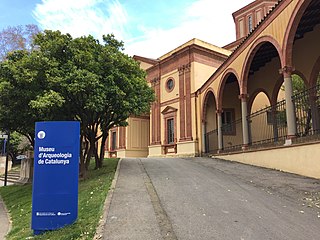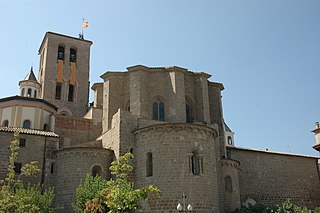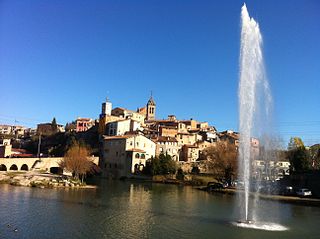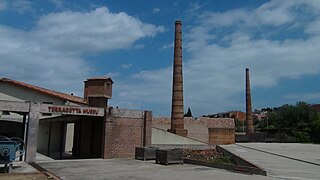
Fish sauce is a liquid condiment made from fish or krill that have been coated in salt and fermented for up to two years. It is used as a staple seasoning in East Asian cuisine and Southeast Asian cuisine, particularly Myanmar, Cambodia, China, Indonesia, Laos, Malaysia, Philippines, Taiwan, Thailand, and Vietnam. Some garum-related fish sauces have been used in the West since the Roman times.

Pa amb tomàquet, or Pan con tomate in Spanish, is a traditional food of Catalan, Valencian, Aragonese, Balearic and Murcian cuisines in Spain. Pa amb tomàquet is considered a staple of Catalan cuisine and identity. While considered a signature toast dish in the Catalan Countries, it is common in bars throughout the rest of Spain, where it is also known either as pan con tomate.

Empúries was an ancient city on the Mediterranean coast of Catalonia, Spain. Empúries is also known by its Spanish name, Ampurias. The city Ἐμπόριον was founded in 575 BC by Greek colonists from Phocaea. After the invasion of Gaul from Iberia by Hannibal the Carthaginian general in 218 BC, the city was occupied by the Romans. In the Early Middle Ages, the city's exposed coastal position left it open to marauders and it was abandoned.

Sitges is a town about 35 kilometres southwest of Barcelona, in Spain, renowned worldwide for its Film Festival and Carnival. Located between the Garraf Massif and the sea, it is known for its beaches, nightspots, and historical sites.

Cardona is a town in Catalonia, in the province of Barcelona; about 90 km (56 mi) northwest of the city of Barcelona, on a hill almost surrounded by the river Cardener, a branch of the Llobregat. To the east of the town, the river has been diverted through a tunnel has been dug through a spur, leaving a loop of dry river bed near the saltmine.

The Archaeology Museum of Catalonia is an archaeological museum with five venues that exposes the most important archaeological collection of Catalonia, focusing on prehistoric times and ancient history. The museum was originally founded in 1932 by the Republican Government of Catalonia. The modern institution was created under the Museums of Catalonia Act in 1990 by the Ministry of Culture of the same Government.

L'Escala is a municipality in the comarca of the Alt Empordà in Girona, Catalonia, Spain. It is situated on the Costa Brava, located between the southern end of the Gulf of Roses and Cala (bay) Montgó. It is an important fishing port and tourist centre, and has a festival dedicated to its famous anchovies. The GE-513 road runs inland from the town.

El Masnou is a municipality in the province of Barcelona, Catalonia, Spain. It is situated on the coast between Montgat and Premià de Mar, to the north-east of the city of Barcelona, in the comarca (county) of el Maresme. The town is both a tourist centre and a dormitory town in the Barcelona Metropolitan Area.

Solsona is a municipality and capital of the comarca of the Solsonès in the province of Lleida, Catalonia, Spain. It is situated in the centre of the comarca in the Catalan Central Depression. It is served by the C-55 road to Manresa, and is linked to Berga and Bassella by the C-26. Until a few years ago, Solsona used to be the main road used by people from Barcelona to go to Andorra.

Sant Carles de la Ràpita is a town in the area of the Montsià in Catalonia, Spain. The town covers a portion of the south-west of the Ebro Delta, including el Trabucador isthmus and la Banya peninsula, which close off a salt water lagoon known as the Port dels Alfacs. The town of Sant Carles de la Ràpita is situated on the coast near the mouth of the lagoon. It was founded by Charles III of Spain as a port to serve trade with the Spanish colonies, and constructed in the neoclassical style of the period. However, much of the town remained uncompleted after Charles' death.

Gironella is a municipality in the comarca of the Berguedà in Catalonia, Spain. It is situated in the left bank of the Llobregat river to the south of Berga. The local economy is traditionally based on cotton spinning and textile manufacture, although tourism is now more important: the company towns or "colonies" of workers houses surround the cotton mills are of historical interest. The town is served by the C-16 road to Berga and the Cadí tunnel. Gironella, which has numerous stores, bars, and schools, is an important economic center for the smaller towns around it, such as Olvan, Sagàs or Casserres.

Pescado frito, also called Pescaíto frito, is a traditional dish from the Southern coast of Spain, typically found in Andalusia, but also in Catalonia, Valencia, the Canary Islands and the Balearic Islands.
Salt Museum may refer to:

Pyrénées-Orientales, also known as Northern Catalonia, is a department of the region of Occitanie, Southern France, adjacent to the northern Spanish frontier and the Mediterranean Sea. It also surrounds the tiny Spanish exclave of Llívia, and thus has two distinct borders with Spain. In 2019, it had a population of 481,691. Some parts of the Pyrénées-Orientales are part of the Iberian Peninsula. It is named after the Pyrenees mountain range.

Anchovies are small, common saltwater forage fish in the family Engraulidae that are used as human food and fish bait. There are 144 species in 17 genera found in the Atlantic, Indian, and Pacific Oceans. Anchovies are usually classified as an oily fish. They are small, green fish with blue reflections due to a silver longitudinal stripe that runs from the base of the caudal fin. They range from 2 centimetres (0.79 in) to 40 centimetres (16 in) in adult length, and the body shape is variable, with more slender fish in northern populations.

The Museum of the Mediterranean is a museum located in Torroella de Montgrí, founded in 2003, in an attempt to become an area for knowledge, reflection and research for the problems and worries that affect citizens in the 21st century. It is housed in Can Quintana, a 16th-century building. It is dedicated to the knowledge and communication of the Mediterranean Sea and uses the natural sounds, human sounds and music to show the reality of the land, the history and the culture of the village of Torroella, connected with the others Mediterranean cultures and towns. It pretends to become a site to think about the nearest territory and the main issues that affect the different Mediterranean nations.

The Terracotta Museum, in La Bisbal d'Empordà, is a museum of pottery and industrial ceramics that was opened in 1991.

'The Castelló d'Empúries Flour Mill and Eco-Museum' is a factory that was open from the late 19th century and during the first half of the 20th century, built on the remains of three medieval flour mills. The Museum opened to the public in 1998, following a renovation carried out by the municipality. It was converted into an ecomuseum with displays covering the flour industry in Catalonia and the great changes that took place in flour production during the second half of the 19th century. It is part of the network of Science and Technology Museums of Catalonia.

The Archaeology Museum of Catalonia in Girona is one of the five venues of the Archaeology Museum of Catalonia, located in the Sant Pere de Galligants Benedictine abbey of Girona since its foundation in 1857. It contains materials found during archaeological excavations at various sites in the province of Girona, dating from prehistory to the Middle Ages.



















